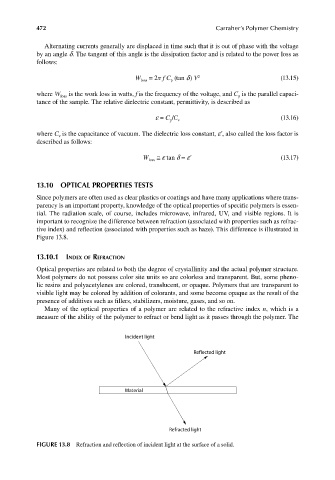Page 509 - Carrahers_Polymer_Chemistry,_Eighth_Edition
P. 509
472 Carraher’s Polymer Chemistry
Alternating currents generally are displaced in time such that it is out of phase with the voltage
by an angle δ. The tangent of this angle is the dissipation factor and is related to the power loss as
follows:
W = 2π f C (tan δ) V 2 (13.15)
loss p
where W is the work loss in watts, f is the frequency of the voltage, and C is the parallel capaci-
loss p
tance of the sample. The relative dielectric constant, permittivity, is described as
ε = C /C (13.16)
p v
where C is the capacitance of vacuum. The dielectric loss constant, ε′, also called the loss factor is
v
described as follows:
W ≅ ε tan δ = ε′ (13.17)
loss
13.10 OPTICAL PROPERTIES TESTS
Since polymers are often used as clear plastics or coatings and have many applications where trans-
parency is an important property, knowledge of the optical properties of specific polymers is essen-
tial. The radiation scale, of course, includes microwave, infrared, UV, and visible regions. It is
important to recognize the difference between refraction (associated with properties such as refrac-
tive index) and reflection (associated with properties such as haze). This difference is illustrated in
Figure 13.8.
13.10.1 INDEX OF REFRACTION
Optical properties are related to both the degree of crystallinity and the actual polymer structure.
Most polymers do not possess color site units so are colorless and transparent. But, some pheno-
lic resins and polyacetylenes are colored, translucent, or opaque. Polymers that are transparent to
visible light may be colored by addition of colorants, and some become opaque as the result of the
presence of additives such as fillers, stabilizers, moisture, gases, and so on.
Many of the optical properties of a polymer are related to the refractive index n, which is a
measure of the ability of the polymer to refract or bend light as it passes through the polymer. The
Incident light
Reflected light
Material
Refracted light
FIGURE 13.8 Refraction and reflection of incident light at the surface of a solid.
9/14/2010 3:42:18 PM
K10478.indb 472 9/14/2010 3:42:18 PM
K10478.indb 472

